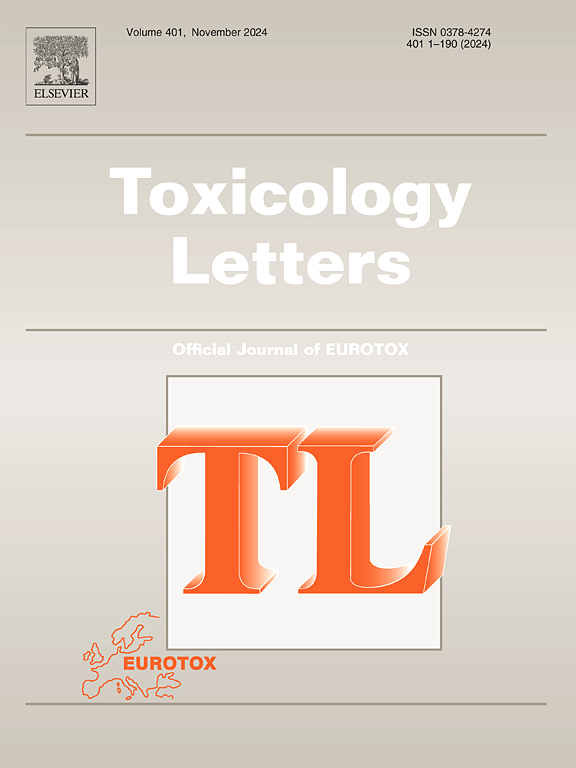Enhancement of cigarette smoke extract-induced goblet cell metaplasia and hyperplasia exerted through IL-13 receptor α1 expression
IF 2.9
3区 医学
Q2 TOXICOLOGY
引用次数: 0
Abstract
Chronic airway inflammation, such as that occurring in chronic obstructive pulmonary disease, induces goblet cell metaplasia and hyperplasia (GCMH) and leads to hyperproduction of mucus and thickening of airway walls, restricting airflow. Cigarette smoke causes chronic inflammation and GCMH in the airways through a complex mechanism involving various factors, including immune cells. Previous studies reported direct effects of cigarette smoke on epithelial cells. Replicating the physiological condition of immune cells, we assessed the interaction between cigarette smoke extract (CSE) and interleukin (IL)-13, a GCMH inducer, on air-liquid interface-cultured normal human bronchial epithelial cells (NHBEs) from a single non-smoking subject. While single exposure to IL-13 or CSE induced mucus production, as previously reported, co-exposure to IL-13 and CSE synergistically enhanced this effect. We also investigated IL-13 receptor expression, which revealed that CSE exposure significantly induced the expression of the functional IL-13 receptor subunit, IL-13Rα1. To analyze the signaling pathway involved, we exposed NHBE cultures to benzo(a)pyrene, an aryl hydrocarbon receptor (AhR) ligand and constituent of CSE, which increased IL-13Rα1 expression in a concentration-dependent manner. Furthermore, treatment with the AhR inhibitor resveratrol erased the effects of CSE on mucus production and IL-13Rα1 expression. Here, we present a novel pathway to GCMH by which cigarette smoke induces IL-13Rα1 expression through AhR stimulation, making epithelial cells sensitive to IL-13. This discovery not only contributes to our understanding of chronic airway inflammation, but also supports the use of in vitro models to reproduce chronic inflammation without co-culture of epithelial cells and immune cells.
香烟烟雾提取物通过IL-13受体α1的表达促进杯状细胞的化生和增生。
慢性气道炎症,如慢性阻塞性肺疾病中发生的炎症,可诱导杯状细胞化生和增生(GCMH),导致粘液分泌过多和气道壁增厚,限制气流。香烟烟雾通过包括免疫细胞在内的多种因素的复杂机制导致气道中的慢性炎症和GCMH。先前的研究报告了香烟烟雾对上皮细胞的直接影响。复制免疫细胞的生理状态,我们评估了香烟烟雾提取物(CSE)和白细胞介素(IL)-13(一种GCMH诱诱剂)在空气-液界面培养的正常人支气管上皮细胞(NHBEs)上的相互作用。虽然如先前报道的那样,单独暴露于IL-13或CSE诱导粘液产生,但同时暴露于IL-13和CSE协同增强了这种作用。我们还研究了IL-13受体的表达,结果显示CSE暴露显著诱导IL-13受体亚基IL-13Rα1的表达。为了分析所涉及的信号通路,我们将NHBE培养物暴露于苯并(a)芘中,苯并(a)芘是一种芳烃受体(AhR)配体,也是CSE的成分,它以浓度依赖性的方式增加了IL-13Rα1的表达。此外,用AhR抑制剂白藜芦醇治疗可以消除CSE对粘液产生和IL-13Rα1表达的影响。在这里,我们提出了一种新的GCMH途径,即香烟烟雾通过AhR刺激诱导IL-13Rα1表达,使上皮细胞对IL-13敏感。这一发现不仅有助于我们对慢性气道炎症的理解,而且还支持使用体外模型在没有上皮细胞和免疫细胞共培养的情况下再现慢性炎症。
本文章由计算机程序翻译,如有差异,请以英文原文为准。
求助全文
约1分钟内获得全文
求助全文
来源期刊

Toxicology letters
医学-毒理学
CiteScore
7.10
自引率
2.90%
发文量
897
审稿时长
33 days
期刊介绍:
An international journal for the rapid publication of novel reports on a range of aspects of toxicology, especially mechanisms of toxicity.
 求助内容:
求助内容: 应助结果提醒方式:
应助结果提醒方式:


